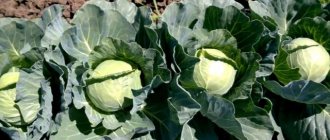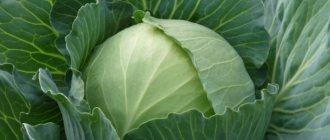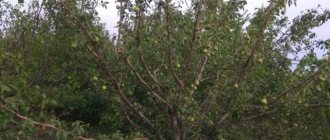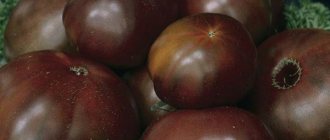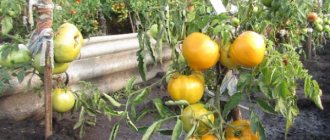Vegetable growing » Cabbage
0
1302
Article rating
Kira Stoletova
Cabbage Golden hectare 1432 is an early variety. It is ideal for both agricultural production and home cultivation.
Characteristics of cabbage variety Golden Hectare
Golden Hectare 1432 - an excellent variety of early cabbage, reviews, photos, cultivation, planting and care
This early-ripening variety of cabbage is grown mainly by farmers in Ukraine and Moldova. But in recent years, Golden Hectare 1432 has been gaining increasing popularity among Russian vegetable growers
.
What is the reason for this, and what characteristics of this vegetable plant appealed to summer residents - this and much more is discussed below.
The content of the article:
History of the variety Description and characteristics of cabbage Golden Hectare 1432 Productivity of cabbage Golden Hectare Advantages and disadvantages Diseases and pests Cabbage Golden Hectare: cultivation, planting Further care of cabbage Feeding Reviews of cabbage Golden Hectare Description from the manufacturer
Characteristic
This is an early ripening variety of cabbage. The full growing season lasts about 100 days (60 when planting 35-day-old seedlings in the ground).
The heads of cabbage ripen almost evenly. The average weight of a mature head is 4 kg. But more often small heads of cabbage weighing 1.5-3 kg grow. They themselves are of medium density, which is generally typical for all early ripening varieties. Due to the presence of a large amount of vitamin C in the Golden Hectare, this cabbage is classified as a dietary product.
The leaf is entire and has a fairly short petiole. The dimensions of the leaf are quite small, round or oval. The leaf color is gray-green. There is a slight waxy coating on the surface. The edge is smooth, less often with slight wavy. The inner stump is short but very thick.
The root of the Golden Hectare is taproot and branching. The root length reaches 40 cm.
This is a high-yielding variety. Under favorable growing conditions, you can collect up to 50-85 tons from 1 hectare of plantings. Or 5-6 kg per 1 m2. These are high figures, since many early varieties cannot boast of such yields.
The yield of marketable products from the entire harvest is 90-99%.
The variety has a fairly strong immunity, which protects against many diseases typical of cabbage. However, the “hectare” is not protected from clubroot at all. Also, as the manufacturer himself notes, the heads of cabbage are not prone to cracking. However, some summer residents who grew this variety noted that when there is an excess of moisture, the heads of cabbage still crack.
As for resistance to climatic conditions, the Golden Hectare tolerates short-term droughts and frosts quite well.
But keeping quality is not very good, in general, like any early-ripening cabbage variety.
Cabbage Golden Hectare 1432: characteristics and description of the variety
White cabbage Golden Hectare 1432 is distinguished by early ripening of heads of cabbage
– from the moment the sprouts appear until the forks are collected, almost 4 months pass.
Golden hectare - harvest video
The leaf rosette of this variety is small, can be up to 70-75 cm in diameter, semi-raised. The foliage can be entire, sessile or with small petioles. Leaf size: length – 33-34 cm, width – 30-32 cm.
The shape of the leaf plates is round, they are flat or slightly concave. The surface of the foliage is smooth, but may be covered with small wrinkles. The edges are smooth or slightly wavy. The venation is medium, resembling a fan in shape. The color of the foliage is emerald with a grayish tint, the waxy coating is of weak or medium intensity.
Photo description of Golden Hectare cabbage from the manufacturer
The shape of the forks is round, the density of the heads of cabbage is quite high. The color of the outer foliage is greenish with a white tint. The size of the inner stump is medium. Weight of heads of Golden Hectare cabbage – from 1.6 to 2.6 kg
.
Ripe forks have good taste, are not prone to cracking, and can withstand transportation well over various distances.
. They are recommended for fresh consumption and are also used for preparing hot dishes, salads and snacks.
Harvesting and storage rules
Ripe heads of cabbage are harvested at the end of July. If stored properly, this cabbage can last until the end of December.
It is usually used fresh - for preparing salads, first and second courses, and also salted.
Since the heads of cabbage rarely grow large enough, it is easier to store them in a cellar or cool basement.
White cabbage Golden Hectare is one of the best varieties with a medium-early ripening period, and can grow in most regions of our country.
And the friendly ripening of heads of cabbage, fairly large yields and a long storage period make Golden Hectare a very popular variety among vegetable growers.
Author of the article: Zvereva Margarita
Advantages of the variety
Vegetable growers call the main advantages of the Golden Hectare cabbage variety:
- high productivity;
- high resistance to some diseases that affect other cabbage varieties, including flowering and cabbage clubroot;
- the variety calmly tolerates short periods of drought, without stopping the growth of the plant and the ripening of the crop;
- heads of cabbage are not prone to cracking, although their density is slightly above average;
- fresh can be stored for up to several months in appropriate conditions, which is a high indicator for an early ripening cabbage variety;
- resistance to major diseases is approximately the same as that of most varieties and hybrids of this vegetable crop.
There are no serious deficiencies noted in this mid-early vegetable.
. But you need to remember that large yields when growing this variety can be achieved only when growing Golden Hectare cabbage on a chernozem type of soil.
When growing on other types of soil, they have to add much more organic matter and complex mineral fertilizers than when growing other varieties of this vegetable crop.
How much money do you need to start a business?
If you decide to open an enterprise specializing in growing cabbage, you need:
- pay for business registration;
- buy inventory and equipment (the issue of expensive equipment can be resolved with the help of leasing companies);
- rent a warehouse, administrative premises and garages;
- purchase the most necessary office equipment (PC, printer, telephones, etc.);
- buy fertilizers and planting material.
The list of costs does not end there. You definitely need to carry out promotional events, buy a plant watering system, build a greenhouse (at least for growing seedlings), and also pay for renting a plot of land. As a result, even to organize the activities of a small farm you need to invest from 5-15 thousand dollars, and if you plan to engage in a larger-scale business, you will need investments 10-20 times more.
Diseases and pests of cabbage crops
The cabbage variety Golden Hectare 1432 is highly resistant to major diseases
, characteristic of other varieties of this vegetable plant. It is also practically not attacked by insect pests.
However, there are a number of diseases that can damage cabbage bushes if improperly cared for or in bad weather conditions:
White rot
, which is characterized by the appearance of plaque on the leaf rosette. This disease most often occurs on this vegetable crop grown in garden beds if the soil on the site is too acidic.
When there is a difference between day and night temperatures or severe cold snaps, the Golden Hectare variety may be affected by powdery mildew
.
To avoid cabbage being affected by various diseases or pests, it is recommended to treat the plantings with copper sulfate or Bordeaux mixture for preventive purposes.
. When the heads of cabbage begin to set, it is recommended to water them with water.
Features of seedling germination
Golden Hectare cabbage is an early variety. It is propagated using the seedling method. Cabbage seeds germinate well at low temperatures. The optimal conditions for growing seedlings are considered to be +18 degrees.
Seeds are sown in the first half of March. For germination, individual peat pots or special containers are used. The soil is suitable ready-made for cabbage or prepared independently. It must first be treated with a disinfecting solution.
Before planting, seeds are soaked in a manganese solution. This increases germination and reduces the risk of disease infection. Until the first shoots appear, the seeds are kept under film at a temperature of +20 degrees. After the first shoots, the film is removed and the temperature is reduced to +10 degrees. A week later, the young plants are again placed in heat, trying to maintain a daytime temperature of +17 degrees and a nighttime temperature of +9.
Seedlings emerge at the stage of two mature leaves. Immediately after transplantation, the plants are kept warm, gradually lowering day and night temperatures again. A certain regime allows you to grow strong, frost-resistant seedlings.
Before planting in open ground, seedlings are fed in 3 stages.
- stage. The first feeding is carried out 10 days after plant picking. Potassium and superphosphate solutions are used.
- stage. Repeated feeding is carried out 10 days after the first application of fertilizer. Ammonium nitrate is used.
- stage. The third feeding is necessary 10 days before planting in open ground. A mixture of potash, ammonia and superphosphate fertilizers is used.
Cabbage seedlings
Planting cabbage Golden Hectare
This variety is unpretentious to growing conditions, and therefore does not require preliminary preparation of beds before planting seedlings or seed material.
But it should be remembered that Golden Hectare cabbage is demanding on lighting, so for planting it you need to choose a well-lit area. In partial shade, Golden Hectare cabbage grows poorly, and the heads of cabbage are not very dense.
Important!
The best soil for growing the Golden Hectare variety is loam or light loam. In soils with high acidity, this vegetable plant will grow poorly and yields will drop sharply.
Although the yield of this variety is quite high, it can be improved if, when preparing the beds, you add organic matter and mineral fertilizers to them. Acidified soil is improved by adding lime or dolomite flour before digging in the fall.
You should also follow the rules of crop rotation and not grow Golden Hectare cabbage after other varieties of this vegetable crop and other cruciferous plants.
Planting cabbage seedlings - video
Golden hectare cabbage can be grown after the following vegetable plants:
- from the nightshade family (peppers, tomatoes, potatoes);
- after legumes;
- after pumpkin;
- Luke.
Usually this variety is grown by seedlings. Growing Golden Hectare cabbage seedlings at home is no different from growing seedlings of other varieties of this vegetable plant.
Cabbage seedlings should be planted in vegetable garden beds at the stage of 3-4 permanent leaves
.
Usually, from the moment the seeds germinate until the Golden Hectare cabbage is transplanted into open ground, at least a month passes.
It is best to plant cabbage seedlings from the second ten days of May, when the return frosts have already passed.
The distance between planted plants should be at least 0.6 m, row spacing - 0.6-0.65 m
. More frequent planting of seedlings leads to poor development of heads of cabbage. The depth of the planting holes must be at least 0.6 m. The seedlings are buried in the soil up to the lower foliage. The soil is compacted and watered; at least 5-6 liters of warm water are added to each plant.
Soil preparation
To grow kohlrabi cabbage in open ground, the area must be kept open, sunny and well protected from the wind. It is not advisable to plant it after crops such as turnips, radishes, tomatoes, beets, and any types of cabbage. After cabbage, it is replanted in this place only after 4 years. Cucumbers and potatoes and dill will serve as good companions for cabbage, but grapes and strawberries will be bad.
When choosing a place to plant, it is worth considering the composition of the soil. It should not contain acidic impurities. If they exist in the selected area, then the soil should be deoxidized (for this, lime or dolomite flour is added). Depleted soil will contribute to a tough harvest.
Therefore, during autumn digging, organic matter is added at the rate of 3 kg per square meter. A good addition to it would be a glass of wood ash and a tbsp. l. superphosphate.
In the spring, digging is carried out with the same additives. After this, the earth is loosened, leveled and watered abundantly.
Further care for cabbage Golden Hectare 1432
This variety of cabbage does not require special care. The main thing when caring for Golden Hectare cabbage is to comply with the watering regime.
, since this vegetable crop loves moisture very much. The top layer of soil should always be moist, and watering is carried out based on this. But you should not allow moisture to stagnate in the soil, otherwise the roots of the plants will rot.
Important secrets of growing and caring for cabbage
The day after watering, the tree trunk circles are loosened to break up the crust that forms on the soil surface and provide oxygen access to the roots.
10-12 days before the expected harvest of heads of cabbage, watering should be stopped.
Temperature
In order for the seedlings to grow strong and form quickly, the temperature regime must be observed. Before the first shoots form, the room temperature should be +19 degrees. After they are formed, the temperature during the day should be +17 degrees, at night - +10 degrees.
14 days before transplanting into open areas, the sprouts need to be hardened off. At the first stage of hardening, the plants need to be gradually accustomed to cool air; several hours a day is suitable for this. At the next stage, the sprouts need to be taken outside.
It is necessary to ensure that direct rays of the sun do not penetrate the inflorescences; for this purpose, create a shadow. The seedlings remain outside for the last couple of days. After 5 leaves appear, the seedlings are dug into an open area.
Cabbage Golden Hectare 1432: plant nutrition
Planted cabbage bushes should be fed at least 3 times per season.
Fertilizing of Golden Hectare cabbage is carried out according to the following scheme:
- the first is applied 2-3 weeks after transplanting the seedlings to a permanent place;
- the second time the cabbage is fed with fertilizers at the stage when the forks begin to ripen;
- During the period of intensive formation of heads of cabbage, a third feeding is carried out.
Rules for feeding cabbage - video
For the first time, fertilizers with a high nitrogen content should be applied to the plants to activate the growth of the vegetative mass
. The following supplements should include potassium and phosphorus, which help strengthen the root system, accelerate the formation of heads of cabbage, and also improve the taste of ripening forks.
Reviews from gardeners
Vladimir Ivanovich, Rostov, 49 years old.
We grow several varieties of cabbage. Among the early ones is the Golden Hectare. We have Golden Acre seeds. Early cabbage, medium-sized head, around 2.5 kilograms, rarely more. The taste is excellent, I would even say very good. In terms of care, it is demanding, like any early variety. Loves fertilizing, compost, mineral water, etc. We have been growing seeds all the time, and last year we purchased seedlings. We regretted this very much. They took it from an unverified person at the market. He told me everything was good, etc., the seedlings are strong and fifth to tenth. As a result, they brought the clubroot to their site. But this is an infection that is very difficult to remove from the garden. Now I'm afraid for the new harvest.
Larisa Alexandrovna, Kyiv, 53 years old.
Overall I liked the variety. The cabbage is early ripe and does not crack. We buy seeds from a trusted place, they germinate well, almost 100%. Despite the fact that many people talk about poor preservation, my Golden Hectare is preserved quite well. Among the shortcomings, I can note the following: the leaves taste a little harsh. Cabbage is slightly sour. And the last drawback is that this is a rather capricious variety that requires good feeding and watering, and this despite the fact that the heads of cabbage generally grow no more than 1.5 kg.
Ekaterina Viktorovna, Minsk, 34 years old.
I like the Golden Hectare. Early cabbage is very different in taste from middle and late cabbage - much sweeter. I use it raw, make fresh salads with mayonnaise or sunflower oil, and prepare cabbage pies from it, adding it to borscht. They say it can be fermented, but I have never fermented early varieties. Seeds germinate 100%. After diving, the sprouts take root very quickly on the site. There is no need to perform any dances with tambourines near the vegetable. I water, fertilize periodically, and hill up once a season. Heads of cabbage of medium density. One of the disadvantages can be noted that cabbage very quickly outgrows and cracks. But if you collect it on time, there will be no problems.
Cabbage Golden Hectare 1432: reviews from those who planted the variety
Natalya, 30 years old, Samara: Of the early varieties of cabbage, I like Golden Hectare 1432 the most. From the moment of sprouting to the harvesting of ripe forks, no more than 4 months pass, so by planting seeds for seedlings, by the beginning of August you can collect the first ripe heads of cabbage with great taste. The forks themselves are dense and of medium weight, so one head of cabbage is enough to prepare dinner for my family.
Ekaterina, 50 years old, Penza: Golden Hectare cabbage is my favorite early variety. It is unpretentious to the place of cultivation and care. In order to get a large harvest, I add humus to the beds in the fall, and in the spring I add mineral fertilizers - superphosphate and ammophosphate - to the holes. In the summer I only water and loosen the soil. As a result, I get a good harvest, part of which I put into storage. I can say that the heads of cabbage from the Golden Hectare lie in my cellar for up to 3.5-4 months, and do not rot, do not lose their taste and presentation.
Excellent varieties of cabbage!
Broccoli Gnome Cauliflower Koza-dereza
Olga, 55 years old, Ryazan: I grow early cabbage specifically for further sale. A couple of seasons ago I planted Golden Hectare cabbage and was quite pleased with the result. The variety is productive, the heads of cabbage are quite dense, with good taste. I sell most of the harvest, but I leave some of the forks for the needs of my family.
Nina, 44 years old, Volgograd: I have been growing the Golden Hectare 1432 variety for several years. I would like to note that during this time the plants were not affected by any diseases, and no pests were visible either. But in order for the forks to be larger, you need to apply fertilizers before planting, and also feed this cabbage several times a season.
Golden hectare cabbage can be grown in most regions of Russia
, and early ripening, high yield, resistance to most diseases and fork cracking make this variety even more attractive for growing in personal plots and small farms. Therefore, those vegetable growers who would like to plant a new variety of cabbage with early ripening on their plot should pay attention to Golden Hectare 1432.
Basic growing rules
Boarding time
In different regions, this white cabbage is planted at different times. Seeds for seedlings are sown from the beginning of March in warmer climatic zones and until the end of April in northern ones. “Golden Hectare” can be planted directly into the soil, with seeds, but the option with seedlings is preferable - this way the crop will ripen earlier.
For seedlings
First you need to select quality seeds.
To do this, they are filled with a 3% salt solution for 4-5 minutes. The floating seeds should be discarded, the remaining seeds should be washed and dried. Additionally, you can remove small seeds, leaving only large and medium ones. At home, selected seeds can be pre-germinated on a damp cloth wrapped in a plastic bag and then moved into the ground. You can either use ready-made soil or make it yourself by mixing turf soil and humus, as well as ash at the rate of 1 tablespoon per 1 kilogram of mixture.
It is best to plant germinated seeds according to this scheme:
in moist soil, you need to make grooves about 1 cm deep, with a distance of 5-6 cm between them; Plant seeds at intervals of about 3 cm, sprinkle them with a small amount of soil; Carefully water the crops or spray them with a spray bottle, cover with film.
After a few days (usually up to a week), seedlings should appear on the surface. From this point on, the film can be removed.
Care
At the seedling stage, plants require standard care: watering and, if necessary, fertilizing. Seedlings are planted in the ground 35-40 days after germination; one and a half to two weeks before this, hardening should begin: the plants can be taken out to the balcony or kept under open windows.
Advice
The ideal temperature for seedlings is 15-17°C during the day and 10°C at night.
To prevent the seedlings from stretching out, the daylight hours should be 13-15 hours.
Moving to open ground
- For planting, it is better to choose light areas with humus-rich loamy soil; cabbage does not grow so well on black soil.
- The soil needs to be prepared by thoroughly loosening it with a rake. It’s good to add humus and ash.
- When planting, the distance between rows of cabbage should be 60 cm, holes can be made at a distance of 45-50 cm.
- Each hole needs to be watered abundantly and then the seedlings should be planted.
- To prevent the appearance of crust, the surface of the bed can be covered with mulch.
By transplantation into open ground, the plants should already have 5-6 leaves.
Aftercare
Further care does not take much time; you need to weed and loosen the beds as needed.
- Two weeks after planting, cabbage can be hilled.
- Fertilizing should be done three times, with a mixture of nitrogen-containing and phosphorus-potassium fertilizers.
- The “Golden Hectare” needs to be watered generously, 2 times a week (as it grows, this interval can be increased to a week - unless, of course, it’s too hot). Cabbage can survive for some time without moisture, but you should not abuse it.
- A week or two before the start of harvesting, watering stops.
Important!
You need to fertilize and feed cabbage three times a season: the first time before planting seedlings, and then once a month.
Harvest and storage
“Golden Hectare” usually ripens in late July-early August (100-110 days after germination).
You can determine that cabbage is ripe by two signs: the heads of cabbage no longer gain weight, and their upper leaves begin to turn yellow. Store harvested cabbage in a cool, dark place. It is best to collect the cabbages in nets and hang them in a place with dry air (this could be a basement or a barn), so the cabbage can last the longest.
Growing problems
If you provide proper care, growing Golden Hectare cabbage will not cause you any problems. The main thing is to choose the right place for planting, since this variety is demanding of soil.
Cabbage Golden Hectare 1432: description and characteristics from the manufacturer
Mid-early variety, from germination to technical ripeness 115 - 120 days. The head is round, light green, medium density, weighing 1.6-3.3 kg.
The variety is productive and relatively resistant to cracking of heads of cabbage. Recommended for fresh consumption. Agricultural technology.
In the middle zone, it is recommended to sow seedlings. Seed placement depth is 1 cm. The optimal germination temperature is 18...20°C, for seedling growth 15...18°C.
Picking at the stage of two true leaves. When planting seedlings in a permanent location, the plants should have 4-6 true leaves. Care: weeding, loosening the soil, pest control, fertilizing and watering.
Agricultural techniques for growing in open ground
In central Russia, the Urals, Siberia and the Far East, early cabbage, including June cabbage, is usually planted in open ground in early May.
It will be much worse if the cabbage is planted 7–10 days late. Then the time for pouring the head of cabbage will fall in hot July. If a fork gets tied, it will certainly be loose or cracked.
Autumn preparation of beds
The bed for cabbage has been prepared since autumn. The soil is dug up, saturated with rotted manure or peat compost, and fertilized with wood ash.
Cabbage beds should be set up in the fall, generously filling them with peat compost.
In addition, the area should be well lit and drained. Drainage outlets can serve as deep furrows along the perimeter of the beds, ordered by area from 20 to 40 m2.
Planting seedlings in open ground
Before planting seedlings in open ground, they must reach 40–45 days of age and acquire 4–5 true leaves. The best time to manipulate seedlings is in the evening after 17-00 on the eve of spring rain.
Cabbage seedlings that have 4–5 true leaves are considered ready for transplanting into open ground
Procedure:
- The holes are dug in the spring and fertilized (despite the fact that in the fall the entire bed was enriched with nutrients). Peat compost or humus is suitable (250–300 g per hole at least 15 cm deep). The fertilizer is mixed with garden soil.
- Before removing plants from their seedling containers, water them thoroughly and allow time for the water to soak into the soil. This technique will make it easier for the roots to emerge from the ground and will not cause serious injury to them.
Before removing plants from seedling containers, water them thoroughly
- The seedlings are removed from the pots and dipped into a solution with a growth stimulator for 1–2 minutes.
Plant roots can be immersed in a solution with a growth stimulator for 1–2 minutes.
- The cabbage root is placed in the center of the hole, covered with soil, watered abundantly and covered again with dry soil so that the moist layer under it is preserved for as long as possible.
The cabbage root is placed in the center of the hole and covered with soil.
Peat pots are installed completely in the hole, the seedling is not removed
Feeding cabbage in open ground
7–10 days after transferring the seedlings to open ground, it is necessary to carry out the first fertilizing. It is necessary in order to:
- give the plant additional immunity from diseases and attacks from garden pests;
- prevent the formation of arrows and the departure of cabbage into the flowering phase;
- promote ovary fork and increase strength in leaves.
Feeding will not only give the plant additional immunity, but will also prevent the formation of shoots
As a nutrient mixture, you can take a solution with the addition of 20 g of ammonium nitrate and 20 g of superphosphate per 10 liters of water. This amount will be enough for 1 m2 of area or four cabbage plants. In addition, there is a number of effective fertilizers that stimulate the formation of the ovary, where all elements are balanced and ordered. These include:
- WMD,
- Agricola,
- Sotka,
- Planta,
- Ovary for cabbage.
After another 7 days, a second feeding is carried out. A solution of mullein in a ratio of 1:10 or a mixture of ready-made fertilizers is suitable. It is advisable to use a different brand of fertilizer to vary the nutritional value.
Applying fertilizers to dry soil is unacceptable - plants should be watered thoroughly before fertilizing
It should be remembered that fertilizing cannot be carried out on dry soil, so a sufficient and abundant spill of clean water before the procedure is mandatory. With insufficient moisture, cabbage leaves suffer, curling and becoming covered with a bluish coating. The best time for fertilizing is considered to be a cloudy morning after an overnight rain.


